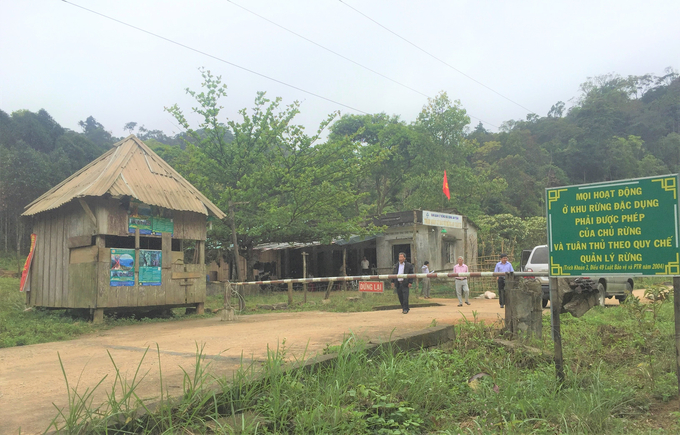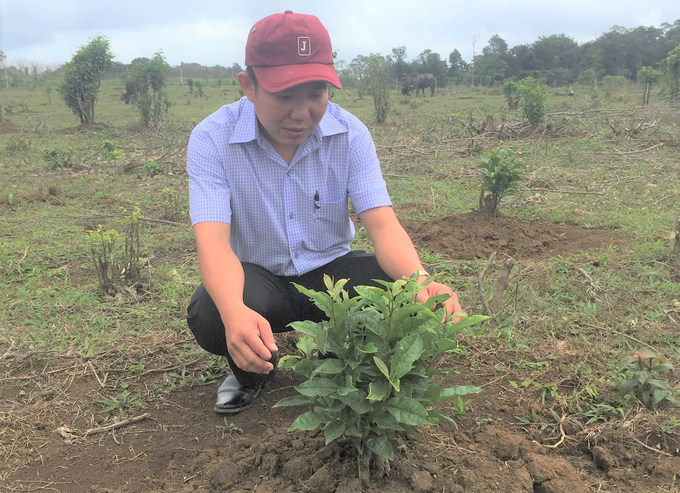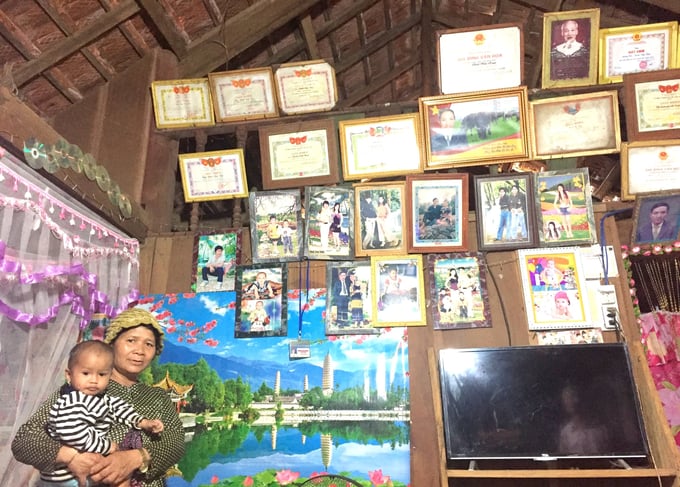November 25, 2025 | 12:29 GMT +7
November 25, 2025 | 12:29 GMT +7
Hotline: 0913.378.918
November 25, 2025 | 12:29 GMT +7
Hotline: 0913.378.918
Prior to ten years ago, loggers avoided the An Toan special-use forest in the An Toan upland village of Binh Dinh province. Mr. Nguyen Hung Nam, director of the An Toan special-use forest, lamented and mourned the loss of the forest while recalling the dark era.

The specialized forest protection force of the An Toan Special-Use Forest Management Board (An Lao district, Binh Dinh) patrols the forest bordering Kbang district (Gia Lai). Photo: V.D.T.
Over 22,500 hectares of primeval forest housing trees with high economic value, such as Tali, Padouk, giang mat, etc., for which loggers had been craved. At that time, when large and valuable timber trees were still thriving in the An Toan special-use forest, loggers fought the competent parties and local authorities to "crossfire" the forest for unlawful exploitation.
The year 2014 was the very last year that the An Toan special-use forest was fiercely exploited. In that year, loggers from Quang Binh collaborated with locals from the neighboring An Lao district to cross the Control Station of An Toan 3 forest gate and access the An Toan special-use forest on motorcycles. When prevented by the competent parties, they argued that only forest products under the canopy should be exploited, not wood. These loggers then continued their voyage into the center of the forest despite being threatened by forest protection forces.

The forest gate checkpoint of the An Toan Special-Use Forest Management Board is located right on the unique road leading into and out of An Toan commune (An Lao district, Binh Dinh). Photo: V.D.T.
Subsequently, the An Toan Special-use Forest Management Board, in collaboration with functional agencies and local authorities, organized a search and uncovered 10 individuals who were coordinating the illegal exploitation of forest products in Sub-Area 51. These hunters left their chainsaws and motorcycles behind and fled into the forest. In Sub-Area 72 of the An Toan special-use forest, functional authorities discovered one cedar tree with a diameter of up to 1 meter that had been cut down.
The An Lao district's People's Committee then planned a long-term search in the An Toan special-use forest. Throughout this sweep, the functional sector found numerous groups of illegal loggers building up camps, stockpiling food, and "settling down" in the forest in order to illegally harvest valuable timber trees. Additionally, forest rangers in the An Lao district uncovered numerous instances of illicit transport of forest products from the An Toan special-use forest to downstream consumers.
While the An Toan forest is being continuously devastated, agricultural production areas in the An Lao district are threatened by drought. During that time, there were nearly 200 hectares of rice and crops in An Hoa, An Tan, and An Trung communes, as well as in An Lao town (An Lao district), that lacked sufficient irrigation water. Not only are the fields parched and parched with thirst, but so are the residents of the aforementioned communities. As soon as authorities in Binh Dinh determined that the An Toan special-use forest with the function of watershed protection had been devastated, leading to the aforementioned circumstance, they devised a plan to strengthen protection.

Mr. Nguyen Hung Nam, Director of the An Toan Special-Use Forest Management Board in the natural tea forest being preserved and developed by the unit. Photo: V.D.T.
On a peak approximately 1,000 meters above sea level, Mr. Nguyen Hung Nam, Director of the An Toan Special-Use Forest Management Board, pointed to the indistinct mountain ranges on the horizon bordering the Kbang district (Gia Lai) and stated, "If you look as far as the eye can see, you will find the boundary of the An Toan special-use forest. More than 22,500 hectares of An Toan Nature Reserve's natural forest are designated as special-use forests.
Presently, the An Toan Special-Use Forest Management Board has only 19 members on its force. It requires considerable effort to assign 15 individuals to full-time forest protection duty. If the entire forest area is divided among the forest protection force, each individual must manage nearly 2,000 hectares of forest, despite the fact that the operation area is distant, the roads are distant, and travel is extremely difficult.
Comparing the human resources to safeguard forests and the forest area, I can't help but be astonished and wonder, "With so few people protecting so much forest area, how did this work? This year, excavators dare not enter the forest, despite the fact that the An Toan special-use forest is still filled with venerable, valuable trees?"

Bana people in the An Toan highland were instructed by technical staff on how to grow tea trees under the forest canopy. Photo: V.D.T.
According to Mr. Nam, in addition to the specialized forest protection force, each of the three villages in the commune has established a forest management and protection group of ten young people with a strong sense of forest protection to coordinate with the specialized forces and patrol and inspect the forest on a regular basis. Each forest patrol lasts from a few to dozens of days, but no one ever refuses and is always enthusiastic. The An Toan have a strong sense of forest preservation because they want the forests to be peaceful so that the forest products that develop beneath the forest canopy will continue to increase, thereby increasing their income.

In addition to the specialized force, in 3 villages in An Toan commune, 3 groups of forest management and protection were established with 30 young people who have a very high sense of forest protection. Photo: V.D.T.
According to Mr. Nam, there are currently 276 households in three villages of the An Toan commune, of which 256 households have signed contracts to protect 7,020 hectares of forest, representing 27.86% of the total natural forest area. On average, each household is contracted to manage 30 hectares for the unit. In addition to a stable source of income from the forest protection contract support of 400,000 VND/ha/year, the An Toan Special Use Forest Management Board is regenerating 100 hectares of natural vine.

The people of An Toan commune have achieved many achievements in forest protection. Photo: VĐT.
In addition, the exploitation of forest canopy net products, such as bamboo stalks and wild honey, provides the people of An Toan commune with numerous other sources of income. Currently, local residents harvest over 5,000 liters of natural honey annually. Currently, the average selling price of wild honey is 300,000 VND per liter, and wild bee pupae are sold for between 300,000 and 350,000 VND per kilogram.
In addition, the An Toan people are flourishing by cultivating medicinal plants such as tea trees beneath the forest canopy, and Binh Dinh Pharmaceutical - Medical Equipment Joint Stock Company (BIDIPHAR) completely covers the products. Here, this is the sustainable means of income for the Bana people.
Translated by Linh Linh

(VAN) Heavy rains make aquatic species more vulnerable to disease. Proactive water management and high-tech systems help farmers prevent outbreaks and protect yields.

(VAN) Greenhouses are shifting production mindsets in Binh Lu commune, enabling farmers to ‘weather the sun and rain’ and secure stable vegetable harvests throughout the year.

(VAN) Green transition is crucial for the Mekong Delta amid climate change and stricter standards, offering a path toward sustainability.

(VAN) Dong Thap promotes agricultural restructuring, forms large specialized farming zones, raises the value of agricultural products and develops toward ecological and high-tech directions.
/2025/11/22/4018-4-213342_747.jpg)
(VAN) The Mekong Delta Agricultural Experts Club has attracted 143 experts and researchers to participate in providing consultancy and contributing initiatives to the development of one million hectares of high-quality rice.

(VAN) Ca Mau’s development of OCOP products opens a path to increasing cooperatives value, helping boost income, expand markets, and affirm collective economy's role.

(VAN) Turning seemingly ordinary coconut shells into unique jewelry and artwork, Nguyen Bang Nhi spreads the value of local culture through her brand, Cocohand.